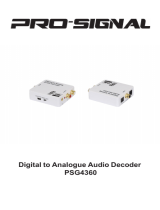
2 ASUS Xonar DGX
1.3 Specications summary
* Specications are subject to change without notice.
Items Description
Audio Performance
Output Signal-to-Noise Ratio (A-Weighted):
105dB for 5.1CH
100dB for Headphone-out@150ohm loading
Input Signal-to-Noise Ratio (A-Weighted):
103dB
Output Total Harmonic Distortion + Noise at 1kHz
(A-Weighted):
Up to 0.0025% (-92dB)
Input Total Harmonic Distortion + Noise at 1kHz
(A-Weighted):
Up to 0.0022% (-93dB)
Frequency Response (-3dB, 24-bit/96kHz input ):
<10Hz to 48kHz
Output/Input Full-Scale Voltage
1Vrms (3Vp-p)
Headphone Impedance
Optimized for 32~150Ω
Bus Compatibility
PCIE
PCIE bus compatible
Main Chipset
Audio Processor
C-Media CMI8786 High-Denition Sound Processor (Max. 96KHz/24bit)
D-A Converter of Digital Sources:
Cirrus Logic CS4245*1 (104dB DNR, Max. 192KHz/24bit) / Cirrus Logic
CS4361*1 (103dB DNR, Max. 192KHz/24bit)
A-D Converter for Analog Inputs:
Cirrus Logic CS4245*1 (104dB DNR, Max. 192KHz/24bit)
Sample Rate and Resolution
Analog Playback Sample Rate and Resolution
44.1K/48K/96KHz @ 16/24bit for all channels
Analog Recording Sample Rate and Resolution
44.1K/48K/96KHz @ 16/24bit
S/PDIF Digital Output
44.1K/48K/96KHz @ 16/24bit, Dolby Digital, DTS, WMA-Pro
ASIO 2.0 Driver Support:
44.1K/48K/96KHz @ 16/24bit
I/O Ports
Analog Output Jack:
3.50mm mini jack *3 (Front/Side/Center-Subwoofer)
Analog Input Jack:
3.50mm mini jack *1 (Line-In/Mic-In)
Other line-level analog input (for CD-IN/TV
Tuner):
Aux-In (4-pin header on the card)
Digital S/PDIF Output
High-bandwidth Optical Connector supports 96KHz/24bit
-additional SPDIF-out header for HDMI audio output
Front-Panel Audio Header
Supports headphone jack-detection, automatically switch audio output from
back-panel to front
Driver Features
Operation System
Windows 10 / 8.1 / 8 / 7 (32/64bit)
Bass Boost
Applies a +6dB boost on 2Khz to 4Khz band of the extracted voice.
Voice Clarity
Enables or disables the compressor audio processing. Works as an auto volume
to ensure a constant loudness.
Compressor
Controls the Compressor Rate between 0 and 1. Threshold, Attack and Release
are preset and not available to the user.
Noise Gate
Enables or disables the Noise Gate audio processing. The Noise Gate cuts the
unpleasant noises between words or sentences for clearer voice communication.
When Noise Gate is disabled, the Perfect Voice can be disabled.
Perfect Voice
Enables or disables the Perfect Voice audio processing. The Perfect Voice has
been designed to analyze and estimate the amount of ambient noise before
eliminating them through spectral subtraction. The Noise Gate is enabled when
Perfect Voice is enabled.
Virtual Surround
Virtual Surround is only for Speaker > audio cong 2.0 and headphones > audio
cong 2.0.
ASIO 2.0 Driver Support:
Supports 44.1K/48K/96K/192KHz @16/24bit with very low latency
Accessories
Accessories
-Low-prole bracket






















